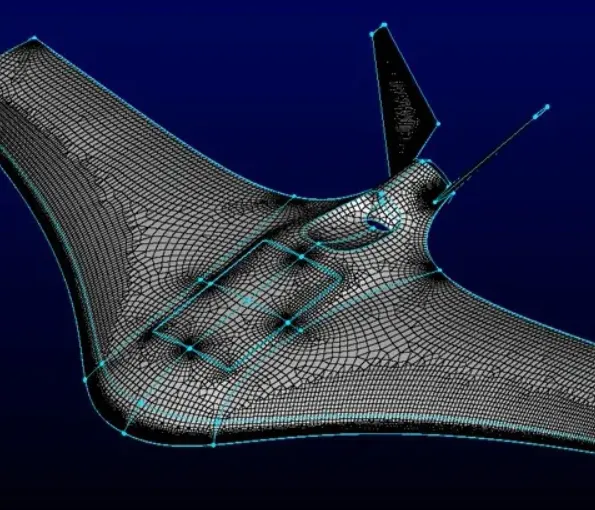When it comes to meshing in CAD design, there has long been a debate over whether to rely on manual or auto meshing techniques. Traditionally, manual meshing was seen as the gold standard for professionals, while auto meshing was considered more of a shortcut for non-experts. But with advances in auto meshing technology, this view is shifting. Is it time to embrace auto meshing as the go-to solution for complex simulations? Let’s explore why auto meshing is quickly becoming a preferred choice for CAD designers and engineers.
What Is Meshing and Why Is It Important?
Meshing is a vital step in computer-aided design (CAD), essential for simulating how a geometric shape behaves under applied forces. The process involves breaking down a continuous model into smaller, manageable elements—typically polygons, such as triangles or quadrilaterals in 2D, and tetrahedra or hexahedra in 3D. This process, known as discretization, is crucial for running accurate simulations, especially when preparing for finite element analysis (FEA) or computational fluid dynamics (CFD).
Discretization essentially turns a complex object into a grid of simpler elements. The density of the mesh—the number of polygons per unit area—directly impacts the accuracy of the simulation. A finer mesh typically provides more detailed results, but it comes with higher computational costs.
The Case for Auto Meshing
Auto meshing algorithms have come a long way in recent years, offering numerous benefits for CAD users. These algorithms automatically generate a mesh by applying a network of line elements and interconnected nodes across the model. While traditional manual meshing offers more control, auto meshing has proven to be a powerful alternative for many reasons.
Benefits of Auto Meshing
- Efficient Mesh Distribution: Auto meshing algorithms can intelligently distribute mesh elements, combining fine and coarse meshes where needed for better accuracy.
- Seamless Mesh Transitions: The software ensures smooth transitions from one element size to another, improving the overall quality of the mesh.
- Enhanced Accuracy: With more sophisticated algorithms, auto meshing provides more reliable mathematical models for simulations.
- Reduced Design Cycle Time: Since auto meshing automates many of the time-consuming tasks, it accelerates the design process without sacrificing quality.
- Cost Savings: By eliminating the need for physical prototypes and reducing time spent on manual mesh creation, auto meshing saves both time and money.
- Streamlined Workflow: Optimized mesh sizes lead to quicker simulations and less prep work, improving overall efficiency.
- Focus on Innovation: With the technical heavy-lifting taken care of, designers can spend more time focusing on innovation and creative aspects of their projects.
Drawbacks of Auto Meshing
- Limited Control: While the algorithm does a great job automating the process, it doesn’t offer the same level of granular control as manual meshing.
- Learning Curve: There’s an initial learning period to get the most out of auto meshing software.
- Higher Initial Costs: The software can come with a higher upfront cost, though it quickly pays for itself with improved efficiency and reduced prototyping expenses.
- Reduced Role for Designers: As the technology advances, some traditional meshing skills may become less relevant, leading to a shift in the designer’s role.
When choosing an auto meshing solution, it’s essential to pick one that integrates well with your CAD system. Software that works seamlessly with popular modeling tools like CGM Modeler or The 3D ACIS Modeler can help automate time-intensive workflows, cutting down on a project’s time to completion.
Manual Meshing: Still a Viable Option?
Manual meshing is the traditional approach where users manually create the mesh, providing them full control over the process. While this method offers its own set of advantages, it also has notable downsides.
Benefits of Manual Meshing
- Total Control: Designers have complete oversight of the mesh creation, allowing for highly customized meshes tailored to specific needs.
- Troubleshooting: Skilled professionals can more easily troubleshoot issues in manually created meshes compared to auto-generated ones.
- Alignment with User Expectations: Since the designer has direct control, manual meshing is often more in line with their specific requirements and expectations.
Drawbacks of Manual Meshing
- Time-Consuming: Creating a mesh manually is a lengthy process, especially for complex models.
- Prone to Human Error: Manual processes are susceptible to mistakes, which can lead to inaccurate results and wasted time.
- Limited Accuracy: While experienced designers can create accurate meshes, manual meshing often doesn’t match the sophistication and precision of modern auto meshing tools.
- High Expertise Needed: Manual meshing requires a high level of expertise to ensure the final model is accurate and reliable.
- Optimization Challenges: Meshes created manually are often less optimized for export or subsequent simulations, leading to inefficiencies down the road.
Conclusion: Auto Meshing Leads the Way
While manual meshing still has a place in some specific applications, the advantages of auto meshing are becoming hard to ignore. The ability to quickly generate high-quality, accurate meshes with minimal effort is revolutionizing CAD workflows. By reducing time spent on mesh creation and ensuring better simulation outcomes, auto meshing offers clear benefits for companies looking to streamline their development processes.
In today’s fast-paced design environment, embracing auto meshing technology can enhance both the efficiency and precision of your CAD models, allowing you to focus more on innovation and less on repetitive tasks.







